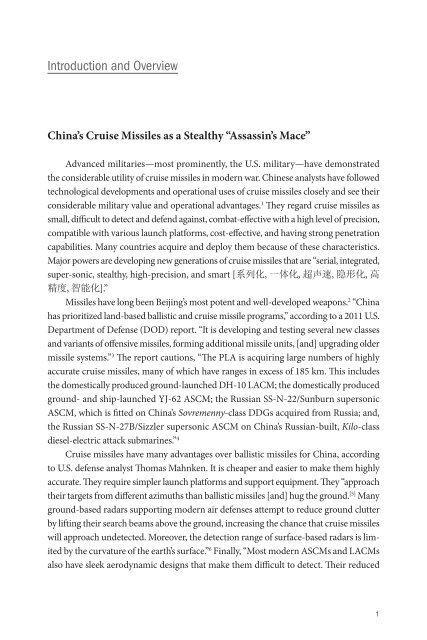You also want an ePaper? Increase the reach of your titles
YUMPU automatically turns print PDFs into web optimized ePapers that Google loves.
Introduction and Overview<br />
China’s Cruise Missiles as a Stealthy “Assassin’s Mace”<br />
Advanced militaries—most prominently, the U.S. military—have demonstrated<br />
the considerable utility of cruise missiles in modern war. Chinese analysts have followed<br />
technological developments and operational uses of cruise missiles closely and see their<br />
considerable military value and operational advantages. 1 They regard cruise missiles as<br />
small, difficult to detect and defend against, combat-effective with a high level of precision,<br />
compatible with various launch platforms, cost-effective, and having strong penetration<br />
capabilities. Many countries acquire and deploy them because of these characteristics.<br />
Major powers are developing new generations of cruise missiles that are “serial, integrated,<br />
super-sonic, stealthy, high-precision, and smart [ 系 列 化 , 一 体 化 , 超 声 速 , 隐 形 化 , 高<br />
精 度 , 智 能 化 ].”<br />
Missiles have long been Beijing’s most potent and well-developed weapons. 2 “China<br />
has prioritized land-based ballistic and cruise missile programs,” according to a 2011 U.S.<br />
Department of Defense (DOD) report. “It is developing and testing several new classes<br />
and variants of offensive missiles, forming additional missile units, [and] upgrading older<br />
missile systems.” 3 The report cautions, “The PLA is acquiring large numbers of highly<br />
accurate cruise missiles, many of which have ranges in excess of 185 km. This includes<br />
the domestically produced ground-launched DH-10 LACM; the domestically produced<br />
ground- and ship-launched YJ-62 ASCM; the Russian SS-N-22/Sunburn supersonic<br />
ASCM, which is fitted on China’s Sovremenny-class DDGs acquired from Russia; and,<br />
the Russian SS-N-27B/Sizzler supersonic ASCM on China’s Russian-built, Kilo-class<br />
diesel-electric attack submarines.” 4<br />
Cruise missiles have many advantages over ballistic missiles for China, according<br />
to U.S. defense analyst Thomas Mahnken. It is cheaper and easier to make them highly<br />
accurate. They require simpler launch platforms and support equipment. They “approach<br />
their targets from different azimuths than ballistic missiles [and] hug the ground. [5] Many<br />
ground-based radars supporting modern air defenses attempt to reduce ground clutter<br />
by lifting their search beams above the ground, increasing the chance that cruise missiles<br />
will approach undetected. Moreover, the detection range of surface-based radars is limited<br />
by the curvature of the earth’s surface.” 6 Finally, “Most modern ASCMs and LACMs<br />
also have sleek aerodynamic designs that make them difficult to detect. Their reduced<br />
1


